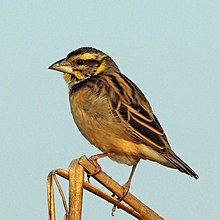Bengal weaver
| Bengal weaver | ||||||||||||
|---|---|---|---|---|---|---|---|---|---|---|---|---|

Bengal weaver ( Ploceus benghalensis ), male in breeding plumage |
||||||||||||
| Systematics | ||||||||||||
|
||||||||||||
| Scientific name | ||||||||||||
| Ploceus benghalensis | ||||||||||||
| ( Linnaeus , 1758) |
The Bengal weaver ( Ploceus benghalensis , Syn. Loxia benghalensis ) belongs to the family of the weaver birds (Ploceidae) to the genus of the bunting weaver ( Ploceus ).
The bird is found in northeast India and southeast Pakistan , southern Nepal, and Bangladesh .
The distribution area includes moist habitats with high grass or reed vegetation near water, preferably near ponds and swamps .
features
The species is 15 cm tall and weighs between 18 and 22 g. Males in brood plumage have a bright golden yellow on the forehead and crown, a light gray to white throat and a wide black collar as a demarcation against the yellowish white underside. The neck and ear covers are dark brown, the top is dark with strong black stripes. The wing-coverts and tail are gray-brown, the rump light brown. In the plain dress, the male looks like the female, no separate parting, brown overall, the black chest band less clear, broad over-eye stripe, dark spot behind the ear and pale yellow, narrow beard stripe are features. The head side is gray, yellow, black longitudinally striped, the underside weakly, the upper side strongly striped black.
The species is monotypical .
voice
The male's song is described as a very gentle series of hissing tones that end in a low hum.

Way of life
The diet consists mainly of seeds, including Japanese millet , glossy grass , bamboo and rice .
The breeding season is between June and September to October. Bengal weavers are polygynous , breed in small colonies , often together with other weaver species. During courtship, the male bows and shows the female his parting, flaps his wings and sings "tsi-tsisit-tsisik-tsik-tsik" like a cricket or the implied squeaking of an unoiled wheel. The nest is like that of the Manyar weavers , but with a smaller, narrower entrance. 3–4 white eggs are laid, which are no different from those of other weavers.
Hazardous situation
The stock is not considered to be at risk ( least concern ).
Web links
- Videos, photos and sound recordings of Ploceus bengalensis in the Internet Bird Collection
- Youtube, building a nest
Individual evidence
- ↑ Bengalenweber , in Avibase - The World Bird Database
- ↑ a b c Handbook of the Birds of the World
- ^ A b S. Ali: The Book of Indian Birds. Bombay Natural History Society, Oxford university Press, 13th ed. 2002, ISBN 978-0-19-566523-9
- ^ R. Grimmett, T. Inskipp: Birds of Northern India. Helm Field Guides, 2017, ISBN 978-0-7136-5167-6
- ↑ Redlist
